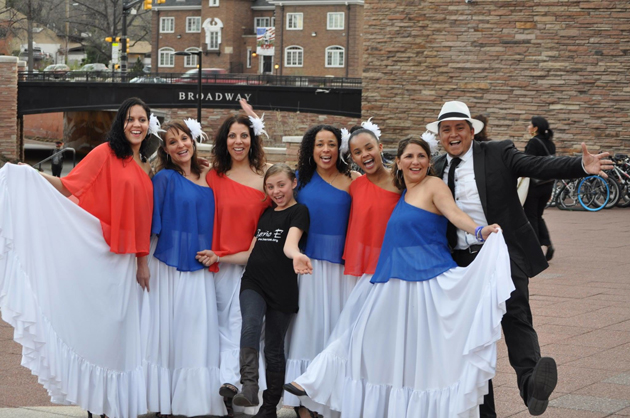
When she was a kid growing up on the east coast, Maria Sepulveda had an intimate connection with her Puerto Rican roots. The Latino community surrounding her was a diverse collection of families from across the Latino world, and she used Spanish with them daily.
“I had a huge amount of respect for Latino culture,” she says.
Today, her two teenage children have a less intimate connection with their heritage.
“We are living in a community where they are the only kids of color in a lot of circumstances,” she says. “My kids had virtually no exposure to Puerto Rican culture other than whatever sad cooking I can do to try and replicate Puerto Rican cooking.”
Since February, Sepulveda has seen her children’s relationship to their cultural heritage change. Increasingly, her kids are engaged with their ancestry, namely because of a Boulder organization called Barrio E (‘Neighborhood Is’).
Founded by husband and wife Tamil Maldonado-Vega and Daniel Leon (which is his second, artistic persona, his first being as City of Their unique and beautiful sound is illuminated through poetic & soulful vocals, spoken word, and an eclectic array of instrumentation.
Mantis Made presents:
with live visuals from Boulder Human Relations Commission board member Jose Beteta), Barrio E is collaborating with artists from around the world for a performance called Influencias: The Legacy of Bomba on Sept. 13 for the Americas Latino Eco Festival. Sepulveda and her daughter and son, Mariella and Javier Hollines, will be performers.
Started in 2012, Barrio E provides its members, through dance and music, with the technique and history of Bomba, a type of dance that demonstrates the convergence of ethnic diver sity in the Caribbean, with influences mainly from Africa, Spain and the Taino people (the indigenous population of Puerto Rico).
Using traditional instruments like goatskin drums, the Sept. 13 performance will present the customary calland-response act that is iconic of Bomba.
Drummers will be drumming, dancers will be dancing, and the audience will be humming along. That kind of community participation is exactly what Maldonado wants. It is exactly the kind of community organizing that is in her blood. and As a child, Maldonado watched her Puerto Rican home get turned into a summer camp every year for neighborhood kids who couldn’t afford summer camp. Her father was in charge of music instruction, there were exercise workshops on the terrace and each room held a group of neighborhood kids working Wed on Oct different 1-Seminar: art projects led Spiritual by Women community Leaders Equinox members. Talks 2014: EDGEWaLKERS “My father took charge of bringing Fri Oct 3- Full Concert Series: Matis Made presents: people together,” Random Rab Maldonado & Lux Moderna says, a legacy she would continue.
The members of Sphere bring a wealth of musical experiences into the group, all having classical training but possessing a diverse background of musical loves and tastes.
When she came to Colorado three years ago, Maldonado searched for an artistic community that included Latinos. She couldn’t find one. So she and Leon founded Barrio E.
“Violence or trouble with immigration is often the topic of discussion when talking about Latinos,” says Maldonado. “Or people think Latinos are only about having fiestas. But the truth is that Latinos are doing so much in our community and bringing so much to a better world vision.”
Leon sees Barrio E and the Americas Latino Eco-Festival as two examples of how Boulder County is working to improve inclusion and awareness of ethnic diversity. You get the feeling he thinks more can be done, but he focuses on the positives, like the fact that he was possibly the first undocumented person in the country to be appointed to a city board (the City of Boulder’s Human Relations Commission), and that Maldonado was awarded Boulder County’s Multicultural Award in the Arts this year.
“Barrio E is a very important component of the [Americas Latino Eco-] Festival because we try to teach people about everybody’s connection with everybody,” says Maldonado.
As
a child, Maldonado grew up in a mountainous community where people
looked out for each other. If someone was growing cassava, someone else
was growing avocados and someone else was growing plantains, people
shared. They used what they needed and they traded what they didn’t with
neighbors.
For
Sepulveda, dreds of years before it became a trend in the U.S.,” he
says. He thinks of his grandparents’ farm in Costa Rica. “Electricity
was more of a luxury. Forget about air conditioning. It was shacks.
The
beds were hammocks. They lived very happily and lived off resources
they had, like the food they planted. I don’t even remember waste at all
because everything was already naturally packaged. It doesn’t come in a
plastic bag, that community-oriented vision lives on in Barrio E, which
doesn’t just attract Latino members, but people from every background.
“I
could gush on and on about how beautiful the mission [of Barrio E] is,”
she says. “You see people from every background. I mean there are
people from India and Ireland in the group. There is total diversity in
the participants, and learning about the history of cultural influences
on Bomba created this safe zone where people started exploring, ‘Hey,
where am I from?’” Bomba gathered bits and pieces of different cultures
across years of tumultuous history, including slavery and colonization.
From African slaves, it inherited the call-and-response singing
technique and the ever-important drums, which were originally crafted
from the cargo barrels Europeans used to transport goods and then topped
with goatskin. From Spanish colonizers, Bomba inherited its iconic
Flamenco-like dancing, consisting of moves that, if captured in
photographs, would produce images making the dancers look caught in a
dramatic pose. From the indigenous Taino people, Bomba inherited the
maraca, made from a cantaloupesize fruit called a higuera.
To
make a maraca, the higuera fruit gets hollowed out, the shell dries and
is then filled with pebbles and seeds that make the “ch-ch” sound of a
maraca. The fruit that was scooped out is inedible, but it is composted.
It’s easy for Leon to connect Bomba to the environmental movement that he says in many ways is just inherent in Latino culture.
“People
were composting for hun- you eat it and the rest you just compost. That
experience made me realize you don’t need much to be happy or to live.
It made me feel like I never really needed to have fancy things to feel
like I was accomplished. It made me feel that the major investment in
life is family, friends and happiness.”
For
Sepulveda, that is exactly what Bomba and Barrio E has provided. The
intimacy she sees growing between her children and their heritage isn’t
just about Latinos.
“Barrio
E has given my kids a chance to share their cultural identity. But in
that, there is more,” she says. “They are bringing it up with their
friends who, in most cases, look totally different from them but who can
then talk about their own history and then they can draw similarities
between their different cultures.”
Watching
a group of Barrio E members practice Bomba rhythms on tall drums wedged
between their legs, you see their hands — brown, whitish brown, white —
fly madly over the goatskin, and it isn’t obvious this is an art form
dating back to the 15th century. Then again, the legacy of Bomba isn’t
just history. It’s still happening.
“A
lot of musical genres spur out of something bad that has happened in
society,” says Leon. “Bomba spurred out of people’s need to be able to
communicate across ethnic divides, to feel community with each other, to
feel strength within the context of hardships going on at that time. It
is music of the people.”
As a free event on Sept. 13, it is music for the people, too.
Respond: [email protected]














